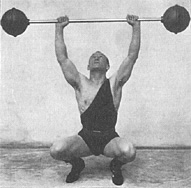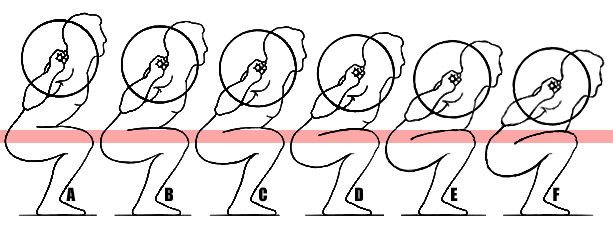The Deep Knee Bend

Prior to the 1930's, performing the deep knee bend usually meant hoisting the bar onto your back without benefit of a squatting cage, stands, or bar supports. If you had training partners who were willing to lift the weight up and off your shoulders, then no problem. But for those training solo, the best method was "rocking" the weight onto one's back (illustrated above). Notice the use of a box to assist in the manuever. Strength legend Henry Steinborn regularly managed to do this sort of thing with well over 500 lbs and this was how he had performed his world record 553 lb lift.
Karl Moerke was another European immigrant during the 1920's who impressed American weightlifters with his powerful squatting ability. Nevertheless, it wouldn't be until Joseph Curtis Hise (pictured above) and his bulking program was revealed in 1932 that squatting became all the rage in this country.
References to squat racks and trestles are made by Mark Berry in writings from the late 1920's but these would remain more a luxury than standard equipment in gyms for several years. Above is John Grimek squatting for a Mark Berry barbell course from 1936. The squat stands he's using appear to be wooden.
Thanks to Steinborn's and Moerke's influence during the early 20's, squatting became a valuable training adjunct to the standard lifts. Two variants of the deep knee bend as practiced by competitive lifters during this period are illustrated above. Overhead squatting in this country was done both ways until the one arm standard lifts were dropped in 1936
High repetition squats and gallons of milk became bodybuilding staples after Mark Berry revealed Joseph Hise's training methods in the August 1932 issue of Strength. Hise's physique had been built with this novel approach and helped spawn a minor revolution in training methodology. Berry would later promote this high rep approach in his own training courses as would Iron Man's Peary Rader.
By the 1940's, the use of high repetition squats as a catalyst for added size had become bodybuilding doctrine. Some examples of different squatting techniques used for "shaping" one's legs are shown in an article from the March 1947 issue of Your Physique. These variations had been around for decades, however.
Back in 1924 muscle guru Alan Calvert was prescribing leg-building routines that included squats on toes with heels together, flat footed squats with heels 20 inches apart, and one partial-range movement like either the "hand and thigh" or "straddle" lift. Those who were interested in weightlifting competition were advised to concentrate on the overhead squatting variations.
The question of what used to constitute "proper" squatting depth is an interesting one. After Henry Steinborn popularized this lift in America as an adjunct to weightlifting practice, "rock bottom" was considered a good training depth for reasons having to do solely with facilitating the overhead lifts.
Going to "full" depth during the 1920's would also be standard practice for squatting in exhibition or as part of a challenge match. Interestingly, the term "full squat" is bandied about quite a bit during this era but no anatomically referenced definition can be found anywhere which stipulates knee or hip landmarks for judging. This was probably not necessary, as one can plainly observe the degree to which the tops of thighs descend below parallel in old photographs from this era. One can only assume that anything higher than this might have been called into question during competition.
After the Amateur Athletic Union (AAU) took over weightlifting in America during the late 1920's, standardized rules governing over 50 different lifts were finally adopted and published. From Bob Hoffman's book Weightlifting (1939), here are the AAU guidelines for the "Deep Knee Bend With Feet Flat":
Official Definition: "Place bar upon shoulders. It is permissable to have it lifted there by assistants. The feet can be held either close together or wide apart as the lifter prefers. Lower until the full squat is reached, then come back to the erect position without assistance from the hands. At the completion of the lift hold the weight for the count of two."
Commentary on Method Of Performance: "The weight may be rocked to the shoulders by the lifter, taken from a trestle or lifted there by assistants. The bar is held in place with the hands. Some men prefer to wrap their arms around the bar. The placing of the feet is most important. Place them in the position that practice proves to be best for you. Lower until the full squat is reached, then raise to the erect position. There are some lifters who use one hand on their thigh to assist in rising, but this is not permissable."
Causes For Disqualification: "Not going to into the lowest possible squat, or assisting with the hands in rising are causes for disqualification. The feet must be on a line, with the knees straight and the back erect when the count is taken."

These AAU squatting guidelines would remain largely in place until the early 1960's.
Okay... so the FIRST AAU set of squatting guidelines (1939) specified that the "lowest possible" thigh position was required to avoid disqualification. Obviously, this particular standard was subject to interpretation since it could be argued that thigh circumference and/or a lack of hip flexibility might influence ones definition/perception of "limit" depth.
Starting in 1964, the AAU definition was reworded to reference the thighs relative to the platform. Now the lifter was required to descend until the "tops of the thighs were below parallel with the platform surface".
Some years later, references to the hip crease and top of the knee as anatomic landmarks were used to further define proper depth. Accordingly, the point at which the hip crease descended below the top of the knee would now be considered sufficiently deep. If one examines the above diagram, one can plainly see that this occurs in the "d", "e", and "f" lifters. One could argue that the "c" lifter also barely makes the grade, although this might be missed by some judges.
